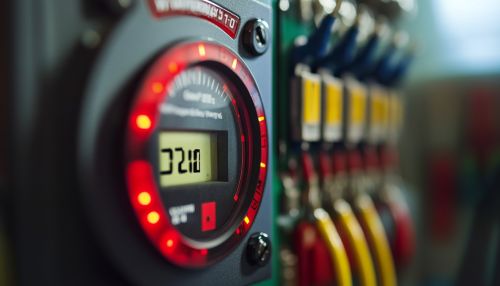Volt: Difference between revisions
(Created page with "== Definition and Units == The volt, symbolized as "V", is the derived unit for electric potential, electric potential difference, and electromotive force in the International System of Units (SI). It is named after the Italian physicist Alessandro Volta, who is credited with the invention of the voltaic pile, considered the first chemical battery. One volt is defined as the potential difference across a conductor when a current of one ampere dis...") |
No edit summary |
||
| Line 7: | Line 7: | ||
The volt is a fundamental unit in the field of [[Electromagnetism|electromagnetism]] and is crucial for understanding how electric circuits function. | The volt is a fundamental unit in the field of [[Electromagnetism|electromagnetism]] and is crucial for understanding how electric circuits function. | ||
[[Image:Detail-98343.jpg|thumb|center|Close-up of a voltmeter displaying a voltage reading.|class=only_on_mobile]] | |||
[[Image:Detail-98344.jpg|thumb|center|Close-up of a voltmeter displaying a voltage reading.|class=only_on_desktop]] | |||
== Historical Background == | == Historical Background == | ||
Latest revision as of 08:41, 9 October 2024
Definition and Units
The volt, symbolized as "V", is the derived unit for electric potential, electric potential difference, and electromotive force in the International System of Units (SI). It is named after the Italian physicist Alessandro Volta, who is credited with the invention of the voltaic pile, considered the first chemical battery. One volt is defined as the potential difference across a conductor when a current of one ampere dissipates one watt of power. Mathematically, this can be expressed as:
\[ 1 \, \text{V} = 1 \, \text{W}/\text{A} \]
The volt is a fundamental unit in the field of electromagnetism and is crucial for understanding how electric circuits function.


Historical Background
The concept of voltage traces back to the late 18th and early 19th centuries, during which significant advancements in the understanding of electricity were made. Alessandro Volta's invention of the voltaic pile in 1800 provided the first continuous source of electric current, which was a pivotal moment in the study of electricity. Volta's work laid the foundation for the development of the concept of electric potential, which later evolved into what we now refer to as voltage.
The term "volt" was officially adopted as a unit of measurement in 1881 at the International Electrical Congress, held in Paris. This standardization was crucial for the advancement of electrical engineering and technology, as it provided a consistent unit for measuring electric potential difference.
Measurement and Instrumentation
Voltage is typically measured using a device called a voltmeter. Voltmeters can be analog or digital, with digital voltmeters being more common in modern applications due to their precision and ease of use. The measurement of voltage is essential in various fields, including electronics, electrical engineering, and physics, as it allows for the analysis and design of electrical circuits.
In addition to voltmeters, oscilloscopes are also used to measure voltage, particularly in applications where the voltage varies with time. Oscilloscopes provide a visual representation of voltage as a function of time, which is invaluable for diagnosing and troubleshooting complex electronic systems.
Applications in Electrical Circuits
Voltage plays a critical role in the operation of electrical circuits. It is the driving force that pushes electric current through a circuit, enabling the circuit to perform work. In a simple circuit, the voltage across a component, such as a resistor, determines the current flowing through it according to Ohm's law, which states:
\[ V = I \times R \]
where \( V \) is the voltage, \( I \) is the current, and \( R \) is the resistance.
In more complex circuits, voltage is used to control and regulate the operation of various components, such as transistors, capacitors, and inductors. Understanding how voltage interacts with these components is essential for designing efficient and functional electronic devices.
Voltage Sources and Types
Voltage can be generated from various sources, each with its unique characteristics and applications. The most common types of voltage sources include:
- **Batteries:** Chemical cells that convert chemical energy into electrical energy. They are widely used in portable electronic devices and as backup power sources.
- **Generators:** Mechanical devices that convert mechanical energy into electrical energy. They are commonly used in power plants to produce electricity for the grid.
- **Photovoltaic Cells:** Devices that convert solar energy into electrical energy. They are used in solar panels to harness renewable energy from the sun.
Voltage can also be classified based on its nature as either direct current (DC) or alternating current (AC). DC voltage remains constant over time, while AC voltage varies sinusoidally, making it suitable for long-distance power transmission.
Voltage in Electronic Components
In electronic components, voltage is used to control and manipulate signals. Transistors, for example, use voltage to switch between different states, enabling them to amplify or modulate signals. Capacitors store and release energy in the form of voltage, while inductors use voltage to create magnetic fields.
Voltage levels in electronic components are often specified in terms of logic levels, which define the binary states of digital circuits. These logic levels are crucial for the operation of digital systems, such as computers and microcontrollers.
Safety and Voltage Hazards
While voltage is essential for the operation of electrical systems, it can also pose significant safety hazards. High voltage levels can cause electric shock, burns, or even death if not handled properly. It is crucial to adhere to safety standards and regulations when working with electrical systems to prevent accidents and injuries.
Personal protective equipment, such as insulated gloves and tools, should be used when working with high voltage systems. Additionally, proper grounding and circuit protection devices, such as fuses and circuit breakers, are essential for ensuring the safe operation of electrical systems.
